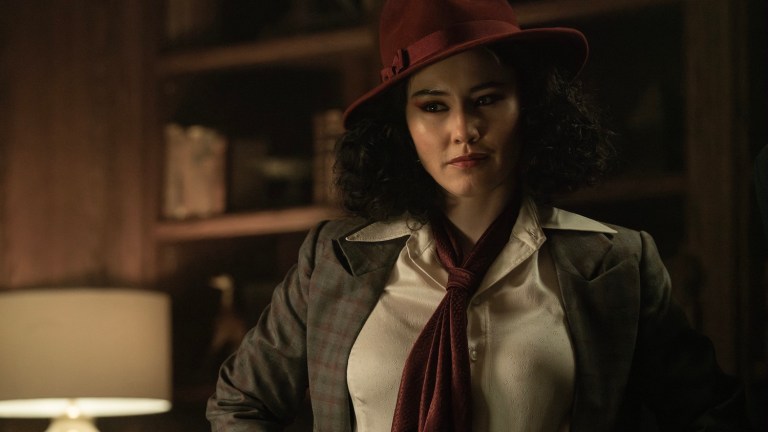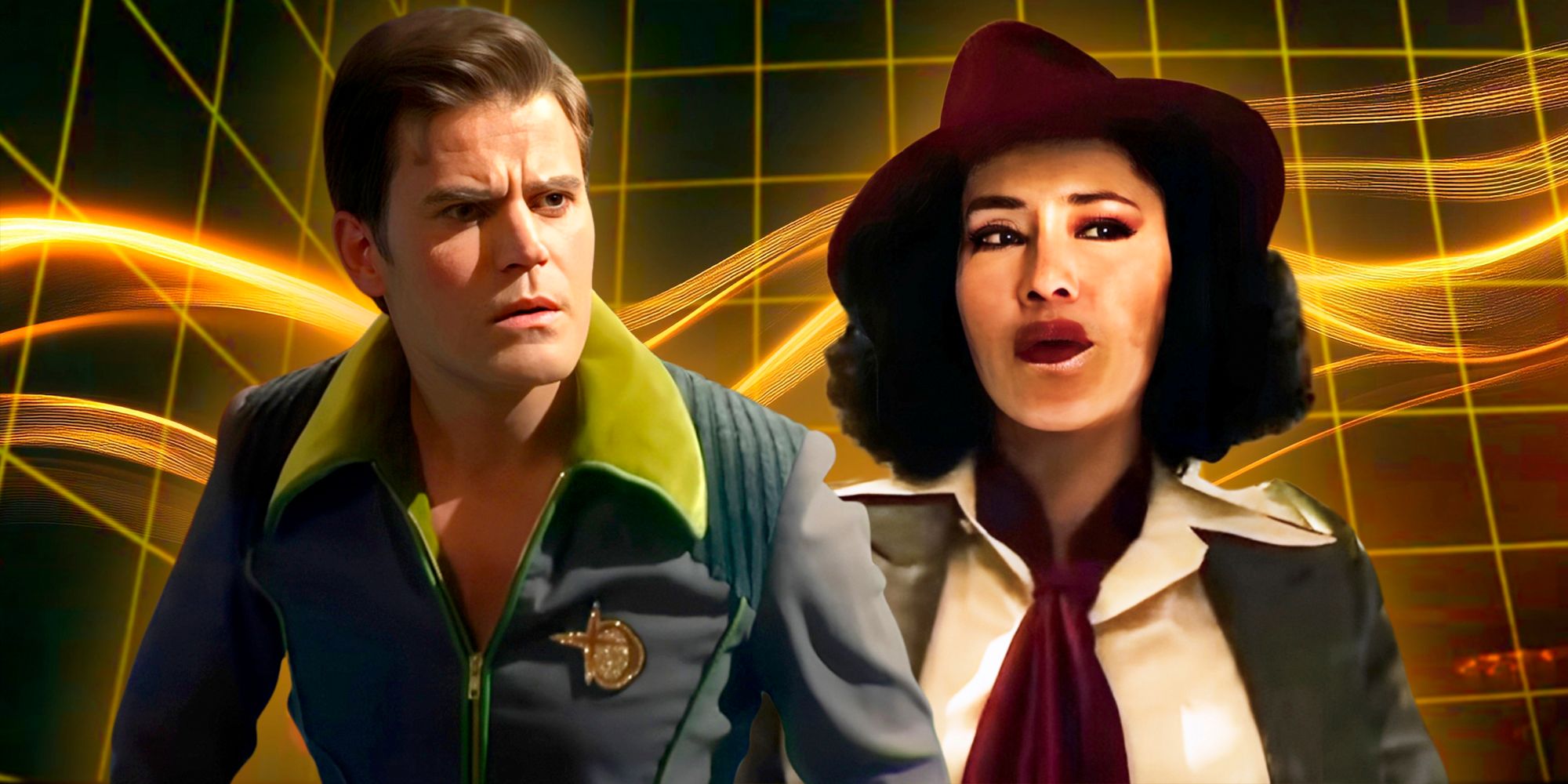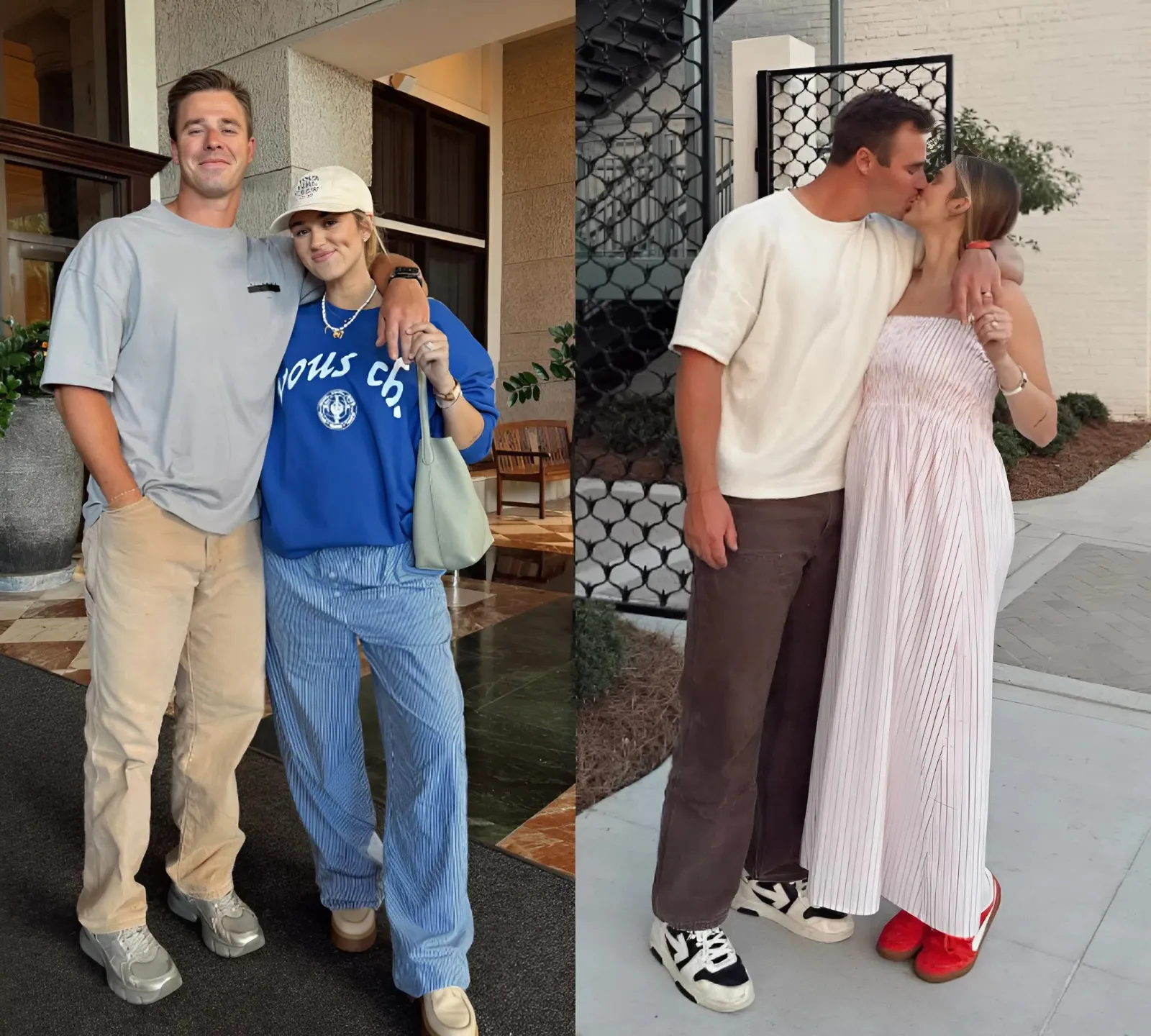
Any sense of vertigo you might feel while watching the first moments of “Space Adventure Hour” is perfectly understandable. In fact, any vertigo you might feel over the course of the episode is perfectly understandable, but let’s start with the opening scene, which opens on an image of Christine Chapel at the controls of a starship. Except it’s not Christine, at least not exactly, though it is Jess Bush. And this isn’t exactly the sort of starship we’re used to seeing on Strange New Worlds, or on any incarnation of Star Trek since the end of the original series. It looks like, well, a TV set, one filled with images and devices that suggest a vision of the future rooted in the mid-1960s — the kind, in other words, you might see on the original Star Trek.
Something else you might see on the ’60s Star Trek: James T. Kirk in the captain’s chair. We see that next in the form of Paul Wesley, who plays James T. Kirk on Strange New Worlds. Only he’s not playing Kirk, but he is delivering his lines with the halting rhythms and emphatic pronunciation of the actor who originated the role, William Shatner. Then, to add to the weirdness, we next see Melissa Navia sporting a wig far removed from Erica Ortega’s familiar haircut and wearing a jumpsuit that looks nothing like any outfit we’ve ever seen on Erica. Whoever these characters are, they’re dealing with a major crisis involving some intimidating, four-eyed creatures called Egonians, an affliction called “melancholia,” the threat of nuclear lasers, and stolen brain cells. The plot really starts to kick into gear when the credits for the show we’re watching start to roll. These, too, look strangely familiar, even if the name is new: The Last Frontier, created by T.K. Bellows.

From there, we’re back on familiar ground, at least for the moment. Things are relatively quiet for the moment aboard Enterprise, which is currently studying a neutron star. That gives La’an some time to head up a project of her own, testing a device that will provide entertainment and stress release for starships that will soon be able to stay away from the Federation for years at a time, thanks to advances in faster-than-light travel. It’s a room that allows crew members to participate in ultrarealistic games and narrative scenarios thanks to holograms. You might even call it a “holodeck.” (But wait — there are no holodecks at this point in Federation history, right? Keep watching.) The Federation is high on this new technology, but it really needs to be put through its paces to make sure it works. That job belongs to La’an.

But first: dancing. Swinging by Spock’s quarters, La’an discovers that he’s kept up with the dance training she started him on, despite his relationship with Christine not going in the direction Spock had hoped. He’s gotten pretty good, too, drawing La’an into a tango and insisting that she keep eye contact with him because, as she puts it when teaching him, “The eyes are the anchor of the tango.” They move well together, which feels like (and turns out to be) a bit of foreshadowing. Spock’s aware of La’an’s holodeck project and wants to help if he can. Even if he’s not that familiar with human entertainment, he does know that violence and “romantic narratives” are popular, noting the latter as they appear to be this close to kissing.
La’an’s not oblivious to what’s happening, but she can’t ignore the bolt of inspiration it unleashes, either. She and Scotty should craft a scenario based on the Amelia Moon mystery novels she adores, tales of an intrepid 1960s sleuth. Scotty’s into it, even though it will be a drain on the ship’s resources. Also, he notes there is “one wee wrinkle.” The holodeck scenario can only realistically create human characters by drawing on the detailed data provided by transporter patterns. In other words, La’an will be interacting with characters who look just like her Enterprise shipmates. It’s a logical explanation that gives “Space Adventure Hour” an excuse to put the Strange New World cast in some fun ’60s costumes while they appear to have a lot of fun playing characters nothing like their proper Strange New Worlds roles.

But first, La’an has to visit the barebones holodeck where, after donning a fun ’60s costume of her own, she finds Spock is already hanging out. Once the program begins, La’an’s immediately impressed. “I can practically smell the ocean and the cigarettes!” she tells Spock before sending him on his way. Almost immediately, she’s set upon by Uhura … er, Jodie Gloss, a high-powered Hollywood agent who wants her to solve the murder of a studio head named Tony Hart, who’s been strangled to death in his expansive estate. Among his studio’s projects, The Last Frontier, and that show’s stars and creators could be the killer.
But who could it be? Gloss? Creator T.K. Bellows (Anson Mount)? Actress turned producer Sunny Lupino (Rebecca Romijn)? One of the stars like Adelaide Shaw (Bush), Maxwell Saint (Wesley), or Lee Woods (Navia)? Adelaide’s artist boyfriend (Babs Olusanmokun)? They all have motives, after all. Hart, it seems, was about to cancel the show.
What happens next? Well, a lot, but the details ultimately don’t matter that much. Sunny dies of poison while deflecting the accusation that she killed (Tony, who was her ex-husband in addition to being her producing partner. They may have broken up, but they had a solid working relationship, and, yes, she put her own money into the show, but she didn’t get it from the Mob.) Though Amelia keeps her cool, this second murder throws La’an, who deduces that the holodeck is behaving like a battle simulator and is trying to defeat her by changing its strategy. She needs a little help. Enter “Detective Spock.” Who is this guy, the Last Frontier folks wonder? A communist? Or, worse, a “cinema snob”?
They may need to get to the bottom of this sooner than planned. The holodeck experiment is causing a real energy drain that’s affecting the rest of the ship. It’s up to Scotty to solve the problem as Una makes clear. He falls back on his default mode of cheerful reassurance. Any problems are “wee.” But the look on Scotty’s face as Una leaves the room suggests that “wee” might not fully cover it. Later, when things heat up, he’ll try to cool them down by quietly seeking Uhura’s help. He likes to get things done without sending anyone into a panic, even if he’s near that state himself.
Back in “California,” “Amelia” and “Detective Spock” turn their attention to Maxwell Saint. Yes, he was having an affair with Hart’s secretary, but that’s really no big deal. Sometimes things happen when people work closely together. Amelia and Spock surely know a thing or two about that, right? Ultimately, this line of inquiry seems like a dead end. So does their talk with Adelaide, who laments that everyone cares more about her love life than her career. Other seeming dead ends: Lee, who’s been working on a screenplay for a western, and her boyfriend.
That leaves Bellows, who shrugs off the suggestion. He wanted to leave to work in movies anyway. “I’m a writer,” he tells the detectives. “We’re never happy about anything.” But maybe there’s more to the story, La’an muses just before she’s nearly smashed by a falling chandelier. She dodges it, but a cut on her face suggests another worrying development: They might get hurt inside the holodeck, even though that’s not supposed to be possible. What’s worse, they can’t shut it off.
From atop a staircase, La’an and Spock watch as the other suspects tear into one another. Noticing Lee is not among them, they go in search of her only to find Jodie hovering over her corpse. Jodie proclaims her innocence, though she strongly disagreed with Hart’s decision to cancel The Last Frontier, “T.K. wanted to give audiences a digestible reflection of their own world through the lens of fantasy,” she explains. “Social commentary with rubber mask and buried metaphors. You know, science fiction.” What’s more, it was a show that could make generations of fans “a place to feel seen, to belong, something to believe in again, no matter who they were or where they come from.”
And there’s that vertigo again. Here’s Celia Rose Gooding delivering an impassioned defense of a socially conscious ’60s science-fiction show with a utopian vision of the future that touches on the power of representation. Gooding, of course, plays Uhura, a role originated by Nichelle Nichols, whose presence as a Black woman in a position of authority on Star Trek had a considerable impact on generations of fans. (Nichols often told the story about how Martin Luther King Jr. persuaded her to stay on when she considered leaving the show after the first season.) It’s a beautifully played and written defense of science fiction in general and Star Trek in particular nested inside an otherwise lighthearted episode.
Jodie’s speech also seems to speak directly to La’an, particularly Jodie’s question, “You don’t think a person can love a piece of art or music or a story so much that it heals them? Shows them parts of themselves they’ve never even seen before?” For La’an, that seems to be the Amelia Moon novels, which she found when she was in a dark place. But since Amelia’s defining characteristic is cracking every case, she returns her attention to the murders.
She needs to hurry. The drain on the ship’s power is putting the Enterprise in serious danger. And despite Scotty’s best efforts to keep this quiet, he now has to answer to Pike. He needs to connect with La’an, but this means finding a way to sneak a message into the simulation. Ultimately, he finds a way, sneaking into the Last Frontier outtake footage La’an is screening, urging her to solve the mystery and end the program.
This will ultimately involve slicing through the Gordian Knot at the heart of the mystery. It could be T.K. Bellows, who shows up drunk after La’an learns The Last Frontier had not been canceled, but Bellows had been fired. But it’s not Bellows, even if he does shoot Spock. Though La’an fears he’s been mortally wounded she finds another discovery instead: It’s been Spock all along. Except it’s not really Spock. The real Spock was never on the holodeck at all but La’an’s chief antagonist, chosen by the holodeck because the program knew she would never suspect him.
With that she’s able to end the program and suggest the Federation mothball the idea (perhaps saving it for the next generation). After Una gives Scotty some reassuring words, La’an visits the real Spock at his request so they can finish the lesson they began earlier. This they do as La’an suggestively recaps the events she experienced on the holodeck. The tension between them builds until they have no choice but to kiss.
How seriously should we take this new relationship? That’s unclear. La’an and Spock have palpable chemistry together, but it’s hard not to see it as a rebound for both characters. Spock’s rather obviously not over Christine, which would be obvious even if we weren’t only two episodes out from “Wedding Bell Blues.” But it’s just as obvious that Kirk remains on La’an’s mind. Her attraction to Spock doesn’t play as the same soul-deep connection as the one seen in her time spent with the alternate universe Kirk. It’s telling that Kirk is the only non-Enterprise crew member to make an appearance in her Amelia Moon fantasy. He’s still on her mind. Or the other Kirk is still on her mind. It gets confusing.
Hit It!
• “I wrote the book on space … jurisdiction. And I am known for my … diction.” Wesley’s having a lot of fun in this episode goofing on Shatner’s onscreen persona (and, to a lesser degree, his off-screen reputation). The only actor who appears to be having even more fun is Mount, who’s never afraid to go goofy when playing characters other than Pike. In appearance and behavior he doesn’t resemble Gene Roddenberry as closely as Wesley’s Shatner tribute, however.
• “Sunny Lupino” pays homage to actress turned director/producer Ida Lupino. Tony and Sunny’s working relationship is a bit of an homage to Desi Arnaz and Lucille Ball, whose Desilu Productions produced Star Trek.
• “I even recommended Pike reinstate Ortegas.” Well, that drama didn’t last very long, did it?
• “As my ancestor, Sir Arthur Conan Doyle, would write, ‘The game is afoot.’” This line is a nod to Star Trek VI: The Undiscovered Country, in which Spock says, “An ancestor of mine maintained that if you eliminated the impossible, whatever remains, however improbable, must be the truth,” a line spoken by Sherlock Holmes in The Sign of the Four. That’s led to a lot of speculation over the years. Nicholas Meyer, who directed Star Trek VI (and Star Trek II: The Wrath of Khan, and who worked on the screenplay to Star Trek IV: The Voyage Home), also wrote The Seven-Percent Solution, a novel that continued the adventures of Sherlock Holmes. (He later adapted it into a movie.) Was he trying to connect his two fictional universes by making Holmes an ancestor to Spock? (I recall once reading a lengthy fan-penned explanation of why Holmes might have been a Vulcan.) Was Spock figurative? Here, he clears it up: He’s related to Holmes creator Arthur Conan Doyle, presumably on the human side of his family.
• “You know what’s not realistic? A lady first officer.” Another vertigo-inducing moment. Majel Barrett originated the role of Una with “The Cage,” the rejected Star Trek pilot that was repurposed as “The Menagerie.” That’s where most viewers first met Una and Pike (played by Jeffrey Hunter). Neither executives nor test audiences apparently responded well to the character at the time.
• “Celluloid film. Discontinued in the 22nd century, many say to the detriment of film.” Preach it, Spock.
• “Warners has rights to a book I’ve been chasin’ …,” Bellows said at one point. Roddenberry’s first major project after Star Trek was the 1971 film Pretty Maids All in a Row, which he wrote but did not direct. It’s based on a novel by Francis Pollini and stars Rock Hudson as a high-school football coach who sleeps with and (spoiler) murders his students. It was directed by Roger Vadim and released by MGM. It’s also Roddenberry’s only credited feature-film work, and, though not a good movie, it’s kind of fascinating as a misanthropic flip side to the optimism at the heart of Trek.



